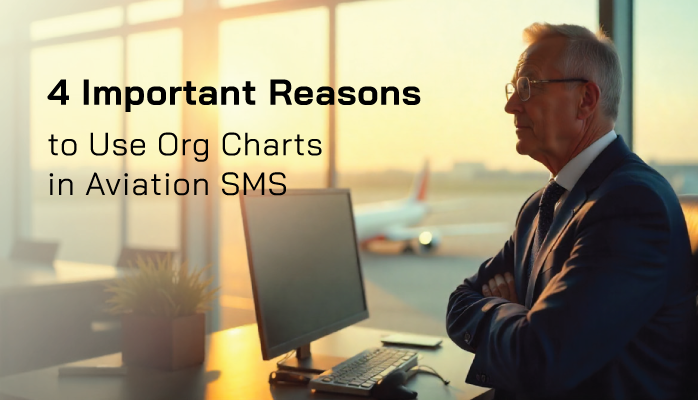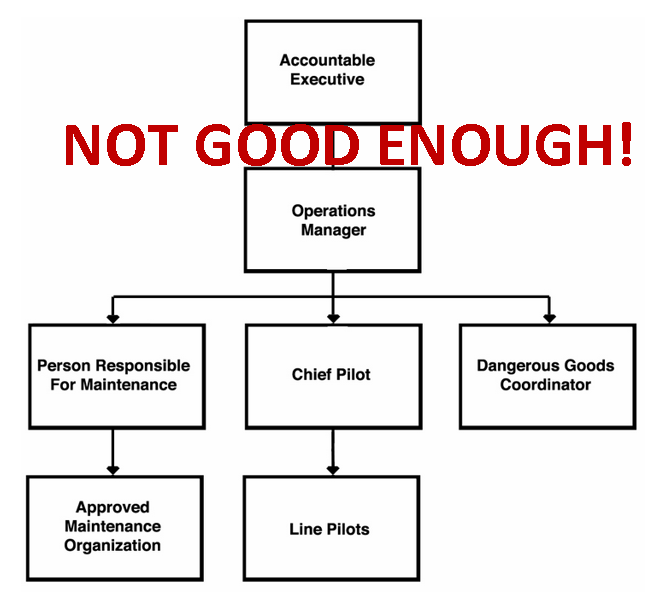Communication to the Right Person Is Good Communication

It’s no secret that many if not a majority of all aviation accidents are a direct result of a lack of communication. Generally, we think of lack of communication as
- No communication whatsoever
- Misinformation or insufficient information
- Misinterpretation of information given
- Another person has no clue as to what's going on
- Cultural interpretation differences
Related Articles on Communication in Aviation SMS
- Let’s Talk Human Factors - Lack of Communication
- Cultivating Teamwork and Communication in Aviation SMS - With Free Resources
- 3 Essential Communication Techniques for Aviation Safety Managers
These points are what poor communication looks like. Poor communication results in the inefficient performance of the aviation safety management system (SMS). High-performing SMS have healthy safety cultures. Healthy safety cultures have both known and open communication channels between management and line employees.
There is another point that is equally as important and can involve clear, well-communicated information, and still be poor communication. That’s an interesting paradox.
Organizational Charts Play Major Role in Aviation SMS Program
Information funneled the wrong way is a serious indication that there is a hole in the SMS organizational structure. I’m often surprised how many organizations have a hastily created or poorly considered org chart in their SMS.
It’s easy to say – especially for smaller organizations – that your organization doesn’t need to waste time creating an org chart. But aviation SMS org charts are important and they serve several important functions that benefit organizations of all sizes.
1 – Visual Guide for Information Flow

When we are talking about what an SMS org chart is, we are talking about the traffic flow of safety information.
When there is an aviation accident or concern, that information will be handed from person to person as if it were a physical object. An org chart structure shows employees and management what happens with that safety information. It can help clarify things like:
- Number of individuals a piece of information goes through
- Whom information goes through
- How many steps in responsibility information passes through
- Who has risk acceptance authority in different organizational departments
Beyond this, org charts can also help answer questions that aviation SMS safety managers should be asking about all information
- Does a piece of information go through the correct people?
- Is information bottle-necking?
- Is the flow of information efficient, and if not, how can it be optimized?
Analyzing org charts is both informative and clarifying and even small companies benefit greatly from seeing what happens to information in their organization. For larger aviation organizations, many of which are extremely complex and prone to communication pitfalls, high-quality safety organization charts are essential.
Most aviation service providers will have a copy of their safety org chart in their SMS manual. However, a best practice is to have an electronic version that is easily accessible by all employees. An org chart communicates the chain of command in an organization; therefore, we can infer that good safety cultures know how information flows in the organization.
A logical location for displaying the org chart is in your online safety portal if you have one. Your online safety portal can be a simple affair, such as your company's safety reporting system. On one of the pages in the safety reporting system, simply add links to:
- a picture of your org chart;
- non-punitive reporting policy;
- reporting policy; and
- accountable executive's signed safety policy.
Advanced SMS databases will offer more features to employees, such as employees:
- reported safety issues;
- assigned safety tasks;
- scheduled safety meetings;
- assigned safety messages; and
- assigned audits.
Very small organizations don't need an SMS database, but you will still need an org chart in your SMS manual.
Related Articles on Organizational Charts in Aviation SMS
- Introduction to Organizational Charts in Aviation SMS
- How to Create an Org Chart for Aviation Safety Management Systems (SMS)
- How to Create Your Aviation SMS Manual
2 – Allocation of Resources
As we all know, human factors play the primary role in accidents and risk management. Most often human error results from either fatigue or overwork. Both tend to be the outcome of too much work and/or too many responsibilities.
Manpower, therefore, is the first and foremost resource in the aviation industry.
When we are talking about the allocation of resources within the framework of SMS, we are really talking about safety accountabilities. What becomes readily apparent when looking at thoughtful and well-produced org charts are:
- The duties of each individual
- Whether or not workloads are evenly distributed
- Based on duties and workloads, where is the greatest likelihood of human error
Having a solid idea of an organization’s allocation of resources is a wonderful way to be proactive, and tweak workloads to mitigate risk.
Related Articles on Proactive Risk Management in Aviation SMS
- Difference Between Reactive, Predictive and Proactive Risk Management in Aviation SMS
- How to Practice Proactive Risk Management in Aviation Safety
- From Reactive to Proactive Risk Management in Aviation SMS
3 – Chain of Command

This is generally the first or only thing one thinks of when they think about an org chart. Org charts are a great tool to show employees:
- How many managers work in the company
- What line of management safety issues/concerns go through
- Who has authority
The end result is that well-designed SMS org charts are effective for satisfying employees that their issues are dealt with in a clear manner, with quick avenues to the top should a serious issue arise. Moreover, it sends a strong message to employees that the safety manager communicates directly with the organization’s executives.
However, a major pitfall for larger organizations is having org charts that are so complicated as to confuse and bewilder the chain of command. It is disheartening for management or employees to see such an org chart.
A good rule of thumb is to, as the top-down process of safety management systems, start with the highest authority, and work down from there in tiers of management.
4 – Hierarchy of Responsibility
This is similar to the chain of command, but the hierarchy of responsibility is less concerned with the levels of management than what is each role’s responsibility with safety information. In other words, while the chain of command is top-down, an employee/manager’s responsibility is probably not that direct.
Simply put, the hierarchy of responsibility tells employees how they are charged with handling information.
For example, a flight safety manager may be responsible for funneling safety information first to the director of flight operations and the maintenance safety officer – who are both probably at the same hierarchical level in the chain of command – before the organization’s safety manager.
Considering the hierarchy of responsibility is a useful way of looking at the SMS org chart because whereas a chain of command shows the ladder of command, responsibility hierarchy shows working relationships.
Final Thought on Org Charts in Aviation SMS Programs
An SMS org chart is separate from a corporate org chart. They are designed solely to visualize what happens with
- reported safety issues,
- accidents, and
- other safety information.
Because org charts are expected in the SMS manual, they can feel like just another SMS requirement. Yet org charts in an SMS are an extremely valuable visual guide, and a useful tool for putting the essential structure of an SMS down in a comprehensive, intuitive, reader-friendly way.
Moreover, showing employees the structure of your aviation SMS is a fundamental tenant in aviation safety transparency.
Safety accountabilities should be outlined for all personnel listed in your aviation SMS org chart. If you need help defining safety accountability in your SMS implementation, these resources will help.
Last updated September 2025.







